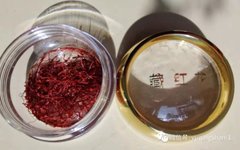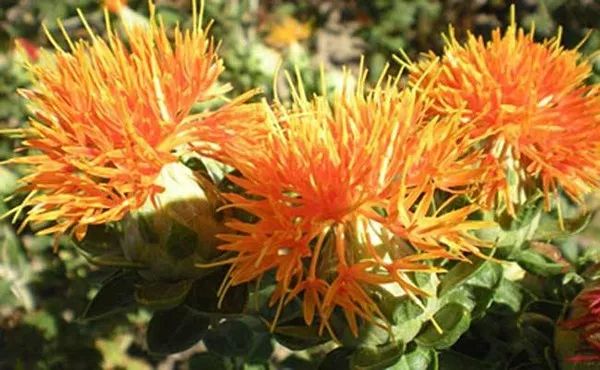
Image of Safflower Plant
Chinese Medicine Name: Honghua (红花)
Alias: Honglanhua (红蓝花), Cihonghua (刺红花), Caohonghua (草红花).
English Name: Carthami Flos.
Medicinal Part: Dried flowers of the plant Carthamus tinctorius L. from the Asteraceae family.
Properties: Warm in nature, pungent in flavor. It enters the Heart and Liver meridians.
Functions: Activates blood circulation, regulates menstruation, disperses blood stasis, and alleviates pain. It belongs to the category of blood-activating and stasis-dispelling herbs.
Clinical Application: Dosage of 3-9 grams, decocted for oral administration.
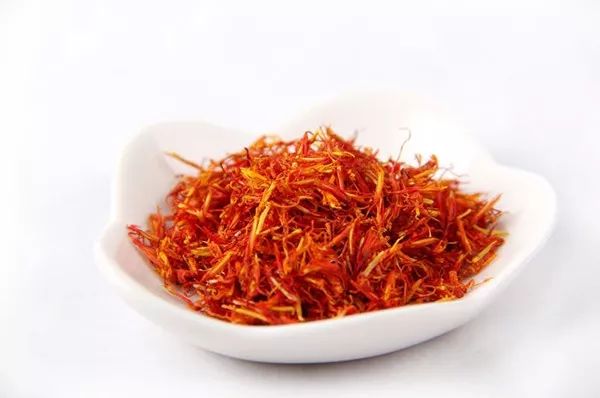
Pharmacological Research: It has a mild stimulating effect on the heart, reduces coronary resistance, increases coronary flow, and enhances myocardial nutritional blood flow; it has anti-myocardial ischemia, myocardial infarction, and arrhythmia effects; improves peripheral microcirculation; has anticoagulant properties; lowers blood lipids; enhances hypoxia tolerance; stimulates the uterus; relieves intestinal spasms; exhibits immune activity and anti-inflammatory effects; can alleviate metabolic disorders of monoamine neurotransmitters in brain tissue; may cause mutations. Animal experiments indicate that small doses of the decoction have a stimulating effect on the heart, while large doses have an inhibitory effect; it has a significant direct constricting effect on blood vessels; safflower yellow pigment can significantly prolong the survival time of mice in hypoxic environments; it has a notable inhibitory effect on ADP-induced platelet aggregation; and has analgesic effects.
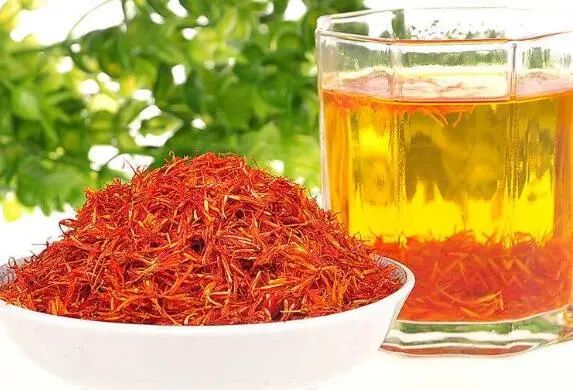
Effects: Activates blood circulation, regulates menstruation, disperses blood stasis, and alleviates pain.
Indications:
1. Treats amenorrhea, dysmenorrhea, postpartum abdominal pain due to blood stasis, retained lochia, abdominal masses, chest pain due to blood stasis, abdominal pain due to blood stasis, flank pain, trauma, and swelling due to stasis.
2. Western medicine diagnoses include dysmenorrhea, cancer pain, angina pectoris due to coronary heart disease, acute and chronic sprains, hepatitis, and swelling due to blood stasis, such as nodular erythema.
Usage of Honghua:
Internal use: 3-9g. — Chinese Pharmacopoeia
Internal use: Decoction, 1-2 qian; included in powder or wine infusion, fresh ones can be crushed for juice. — Dictionary of Chinese Medicine
External use: Ground into powder and sprinkled. — Dictionary of Chinese Medicine
Internal use: Decoction, 3-10g. Nourishing blood and harmonizing blood should be used in small amounts; activating blood and dispelling stasis should be used in larger amounts. — Chinese Herbal Medicine
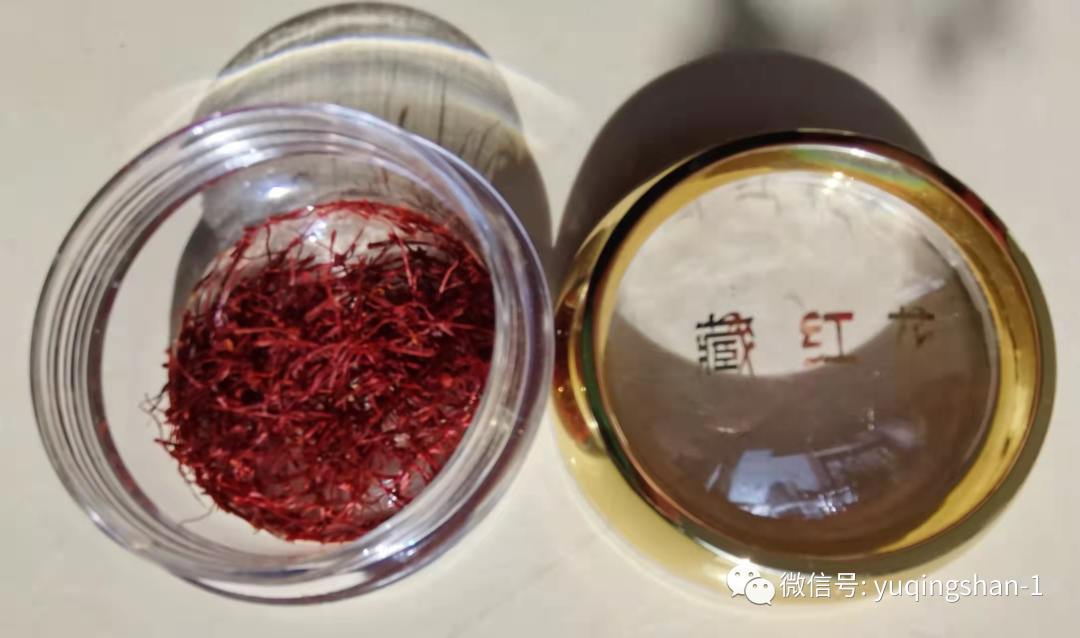
Honghua Combinations:
Note: The following formulas should be used under the guidance of a physician.
Clinical Applications:
1. For dysmenorrhea, can be used alone, such as Jinkui Yaolue Honglanhua wine, decocted with this herb and wine; can also be combined with Chishao (赤芍), Yanhusuo (延胡索), and Xiangfu (香附) to regulate qi, activate blood, and relieve pain.
2. For amenorrhea, can be combined with Danggui (当归), Chishao (赤芍), and Taoren (桃仁), such as in Taohong Siwu Decoction (《医宗金鉴》).
3. For postpartum abdominal pain due to blood stasis, can be combined with He Ye (荷叶), Puhuang (蒲黄), and Mudanpi (牡丹皮), such as in Honghua San (《活法机要》).
4. For abdominal masses, commonly combined with Sanleng (三棱), E’zhu (莪术), and Xiangfu (香附).
5. For chest pain, commonly combined with Guizhi (桂枝), Gualou (瓜蒌), and Danshen (丹参).
6. For abdominal pain due to blood stasis, commonly used with Taoren (桃仁), Chuanxiong (川芎), and Niuxi (牛膝), such as in Xuefu Zhuyu Decoction (《医林改错》).
7. For flank pain, can be used with Taoren (桃仁), Chaihu (柴胡), and Dahuang (大黄), such as in Fuyuan Huoxue Decoction (《医学发明》).
8. For trauma and swelling due to stasis, it is a key herb, commonly combined with Muxiang (木香), Sumac (苏木), Frankincense (乳香), and Myrrh (没药); or made into safflower oil or tincture for topical application.
9. For dark-colored rashes due to heat and stasis, commonly combined with clearing heat and cooling blood herbs like Zicao (紫草) and Daqingye (大青叶), such as in Danggui Honghua Decoction (《麻科活人书》).
1. For women with obstructed menstruation, such as blood stasis: Honghua (细擘), Su Mu (苏枋木, crushed), and Danggui in equal parts. Finely chop, use 1 liang, with 1.5 liters of water, first decoct the flower and wood; then add 1 cup of wine and Danggui, decoct again, take warm before meals. (《朱氏集验医方》)
2. For heat disease causing fetal death: Safflower wine decoction, drink 2-3 cups. (《妇人良方补遗》)
3. For retained placenta: Safflower wine decoction, drink 2-3 cups. (《产乳集验方》)
4. For various pains in women: Honglanhua 1 liang, with 1 large sheng of wine, decoct until reduced by half, take half at once, if not relieved, take again. (《金匮要略》 Honglanhua wine)
5. For all swellings: Honglanhua, crushed and juiced. (《外台秘要方》)
6. For throat obstruction: Fresh Honglanhua juice, 1 small sheng, take it. If there is no moisture in winter, soak the dried ones to extract juice as before. (《海上集验方》)
7. For chronic ear discharge: 1 fen of Honghua, 1 liang of white alum (burnt to ash). Grind finely, use a small amount in the ear. (《圣惠方》)
8. For trauma and wall injuries: 1 fen of Chuanma, 2 fen of Muxiang, 3 fen of Honghua, and 4 fen of Licorice. Use raw, grind into powder, take with yellow wine. (《急救便方》)
9. For bedsores: Appropriate amount of Honghua, soak in wine for external application. (《云南中草药》)
Formulations:
1. For dysmenorrhea: 6g of Honghua, 24g of Jixueteng. Decoct and take with appropriate yellow wine. (《福建药物志》)
2. For women with obstructed menstruation: Honghua (细擘), Su Mu (crushed), and Danggui in equal parts: each use 30g, with 1.5 liters of water, first decoct the flower and wood. Then add 1 cup of wine and Danggui, decoct again. Take half a liter, divided into two doses, on an empty stomach, warm. (《朱氏集验医方》 Honghua San)
3. For cough and shortness of breath due to reversed menstruation: Honghua, Huangqin, Su Mu each 2.4g, Tianhuafen 1.8g. Decoct and take on an empty stomach. (《竹林女科》 Honghua Decoction)
4. For cervical cancer: Honghua, white alum each 6g, Wason 30g. Decoct, first fumigate then wash the external genitalia, 1-2 times daily, each time for 30-60 minutes, reheat for next use, each dose can be reused for 3-4 days. [《上海中医药杂志》1984,(9):9]
5. For initial swelling and pain: Honghua, and crushed pangolin each 15g, Guiwei 9g. 2 cups of yellow wine, decoct to 1 cup. Add 1.5g of Ferula and 0.15g of Musk. (《外科大成》)
6. For red swelling and half-body redness: Honghua powder, mixed with vinegar for external application. (《小儿卫生总微论方》)
7. For chronic ear discharge: 0.3g of Honghua, 30g of white alum (burnt to ash). Grind finely, use a small amount in the ear. (《圣惠方》)
8. For trauma and wall injuries: 1 fen of Chuanma, 2 fen of Muxiang, 3 fen of Honghua, and 4 fen of Licorice. Use raw, grind into powder, take with yellow wine. (《急救便方》)
9. For bedsores: Appropriate amount of Honghua, soak in wine for external application. (《云南中草药》)
Related Formulations:
1. For dysmenorrhea: 6g of Honghua, 24g of Jixueteng. Decoct and take with appropriate yellow wine. (《福建药物志》)
2. For women with obstructed menstruation: Honghua (细擘), Su Mu (crushed), and Danggui in equal parts: each use 30g, with 1.5 liters of water, first decoct the flower and wood. Then add 1 cup of wine and Danggui, decoct again. Take half a liter, divided into two doses, on an empty stomach, warm. (《朱氏集验医方》 Honghua San)
3. For cough and shortness of breath due to reversed menstruation: Honghua, Huangqin, Su Mu each 2.4g, Tianhuafen 1.8g. Decoct and take on an empty stomach. (《竹林女科》 Honghua Decoction)
4. For cervical cancer: Honghua, white alum each 6g, Wason 30g. Decoct, first fumigate then wash the external genitalia, 1-2 times daily, each time for 30-60 minutes, reheat for next use, each dose can be reused for 3-4 days. [《上海中医药杂志》1984,(9):9]
5. For initial swelling and pain: Honghua, and crushed pangolin each 15g, Guiwei 9g. 2 cups of yellow wine, decoct to 1 cup. Add 1.5g of Ferula and 0.15g of Musk. (《外科大成》)
6. For red swelling and half-body redness: Honghua powder, mixed with vinegar for external application. (《小儿卫生总微论方》)
7. For chronic ear discharge: 0.3g of Honghua, 30g of white alum (burnt to ash). Grind finely, use a small amount in the ear. (《圣惠方》)
8. For trauma and wall injuries: 1 fen of Chuanma, 2 fen of Muxiang, 3 fen of Honghua, and 4 fen of Licorice. Use raw, grind into powder, take with yellow wine. (《急救便方》)
9. For bedsores: Appropriate amount of Honghua, soak in wine for external application. (《云南中草药》)
Adverse Reactions:
1. Improper use of Honghua can lead to poisoning, with symptoms mainly manifesting as abdominal discomfort, abdominal pain, diarrhea, and even gastrointestinal bleeding, abdominal cramps, excessive menstrual bleeding in women, and in some cases, mental confusion, tremors, and severe cases can lead to convulsions, respiratory stimulation followed by inhibition, leading to circulatory and respiratory failure; a few patients may experience dizziness, rashes, and transient urticaria.
2. Early poisoning should be treated with physiological saline gastric lavage, followed by general detoxification agents (20g of activated charcoal, 10g of magnesium oxide, 5g of tannic acid, 100ml of water) or intravenous infusion of 5% glucose saline and glucose solution with vitamin C.
3. For those with bleeding, a hemostatic agent can be added to the glucose solution. For convulsions, sedatives should be administered. In cases of circulatory and respiratory failure, stimulants and cardiotonics should be used. For allergic reactions, anti-allergic treatment can be given. Local drug rashes can be treated with calamine lotion.
Contraindications:
1. Contraindicated in combination with nephrotoxic drugs such as Mutong (木通), Fangji (防己), and Aristolochia (马兜铃).
2. Contraindicated in combination with antihypertensive drugs.
3. Contraindicated in combination with aspirin and norepinephrine, as it may exacerbate adverse reactions.
Precautions:
Usage Contraindications: Pregnant women and those with excessive menstrual bleeding should avoid use.
Chemical Composition: Contains safflower glycosides, new safflower glycosides, safflower glycosides, pre-safflower glycosides, tritriacontane, β-sitosterol, and di-palmitic acid, glycerol esters, oleic acid, linoleic acid, chlorogenic acid, and 13 other components of safflower yellow pigment and yellow pigment. Also contains safflower oil, which includes palmitic acid, myristic acid, lauric acid, stearic acid, and oleic acid.
Pharmacological Effects:
1. Effects on the cardiovascular system: Honghua mildly stimulates the heart, reduces coronary resistance, increases coronary flow, and enhances myocardial nutritional blood flow, protecting and improving myocardial ischemia, and reducing the area of myocardial infarction; safflower yellow pigment can counteract arrhythmias; decoctions, water extracts, and safflower yellow pigment can dilate peripheral blood vessels and lower blood pressure.
2. Effects on blood rheology: Honghua can anticoagulate, prevent thrombosis, reduce whole blood viscosity, and maintain normal blood viscosity.
3. Effects on the nervous system: Safflower yellow pigment has analgesic, sedative, and anticonvulsant effects on the central nervous system. Injection solutions, alcohol extracts, and safflower glycosides can significantly improve hypoxia tolerance, reduce ischemic brain edema, and protect tissues in experimental cerebral infarction animals.
4. Effects on the liver and gallbladder system: Honghua can lower alanine aminotransferase and improve liver function.
5. Effects on the metabolic system: Honghua can lower serum total cholesterol, triglycerides, and non-esterified fatty acid levels.
6. Effects on reproductive organs: Honghua decoction has a stimulating effect on the smooth muscles of the uterus and intestines, and can prevent pelvic adhesions. In addition, safflower alcohol extracts and water extracts have anti-inflammatory effects, and safflower yellow pigment has immunosuppressive effects.
Toxicological Effects:
Honghua decoction at 1g/kg injected into mice shows no toxic reactions. 1.2g/kg is the minimum toxic dose; 2g/kg is the minimum lethal dose. The LD50 is 2.4±0.35g/kg by intraperitoneal injection and 20.7g/kg by oral administration. Symptoms of poisoning include lethargy, reduced activity, and difficulty walking. The LD50 of safflower alcohol extract is 5.3g/kg by intravenous injection. The LD50 of safflower yellow pigment is 2.35g/kg by intravenous injection, 5.4g/kg by intraperitoneal injection, and 5.53g/kg by oral administration. When the dose increases to 7g/kg by intraperitoneal injection or 9g/kg by oral administration, 100% mortality occurs in mice. Symptoms of poisoning include increased activity, unsteady movement, rapid breathing, tail elevation, convulsions, and respiratory suppression leading to death. It has also been reported that safflower yellow pigment at 8g/kg by oral administration shows no significant toxic symptoms. Feeding mice with 6% safflower powder for over a month shows normal weight; feeding with 8%-10% safflower powder leads to weight loss; increasing the dose can cause death. Rabbits fed 0.55g/kg daily for 10 days, and young rats fed with safflower powder mixed into their feed at a daily intake of about 0.015g/kg-1.5g/kg for 3 months showed no significant changes in blood counts and liver and kidney functions, and no abnormalities were found in the morphology of the heart, liver, kidney, and gastrointestinal organs. Bacterial mutation experiments indicate that safflower extract has significant mutagenic effects.
Related Discussions:
1. Newly Revised Materia Medica: Treats mouth closure and blood clots, and various postpartum diseases.
2. Materia Medica Compendium: Honghua is a medicine that breaks blood, moves blood, harmonizes blood, and regulates blood.
Processing and Preparation:
Harvesting and Processing:
Flowers bloom in late May, with peak flowering from late May to mid-June, harvested in batches. Choose sunny days, harvest in the morning from 6-8 am, when the tubular flowers are fully opened and golden yellow; if harvested too late, the tubular flowers wilt and turn red-black, making harvesting difficult and reducing quality and yield. After harvesting, dry in the shade or dry at low temperatures of 40-60℃.
Preparation Methods:
1. Honghua: Take the raw material, remove impurities, flower calyx, and flower stalks, and screen out ash.
2. Fried Honghua: Place clean safflower in a pan, fry over low heat until slightly charred, then remove and cool.
3. Safflower Charcoal: Place clean safflower in a pan, fry over high heat until reddish-brown, sprinkle with a little water to extinguish fire, then remove and cool.
4. Vinegar Honghua: Spray safflower with vinegar, mix well, then place in a pan and fry until dark red, then remove and cool. For every 100kg of safflower, use 20kg of vinegar.
Storage Methods:
Store in a dry container, vinegar safflower should be sealed and placed in a cool, dry place to prevent moisture and pests. Safflower charcoal should be stored to prevent re-ignition.
Identification of Medicinal Materials:
Identification:
1. The powder of this product is orange-yellow. Fragments of flower crowns, filaments, and styles are commonly seen, with long tubular secretory cells often located next to the ducts, approximately 66μm in diameter, containing yellow-brown to red-brown secretions. The outer wall of the epidermal cells at the tips of the flower crown lobes is raised into short hair-like structures. The epidermal cells on the upper part of the style and stigma differentiate into conical single-cell hairs, with pointed or slightly blunt tips. Pollen grains are round, oval, or olive-shaped, approximately 60μm in diameter, with 3 germination pores, and the outer wall has serrated protrusions. Calcium oxalate crystals are present in parenchyma cells, measuring 2-6μm in diameter.
2. Take 0.5g of this product powder, add 5ml of 80% acetone solution, seal tightly, shake for 15 minutes, let it stand, and take the supernatant as the test solution. Take 0.5g of safflower reference material and prepare the reference material solution in the same way. Perform thin-layer chromatography (TLC) test, applying 5μl of each solution on the same silica gel H thin-layer plate, using ethyl acetate-formic acid-water-methanol (7:2:3:0.4) as the developing agent, develop, remove, and dry. In the test solution chromatogram, at the corresponding position of the reference material chromatogram, the same colored spots should appear.
Medicinal Material Properties:
It consists of tubular flowers without ovaries, measuring 1-2cm in length. The surface is red-yellow or red. The flower crown is long and slender, with 5 lobes at the tip, the lobes are narrow and 5-8mm long. There are 5 stamens, the anthers are aggregated into a tubular shape, yellow-white. The style is long cylindrical, slightly bifurcated at the tip. The texture is soft. It has a faint fragrance and a slightly bitter taste. The best quality has long flower crowns, bright red color, and soft texture without thorns.
Herbal Slice Properties:
1. Honghua: Refer to the properties of medicinal materials.
2. Fried Honghua: Similar in shape to safflower, with a deepened color and slight charred spots.
3. Safflower Charcoal: Similar in shape to safflower, reddish-brown.
4. Vinegar Honghua: Similar in shape to safflower, dark red, with a slight vinegar smell.
Botanical Information:
Plant Species: Safflower from the Asteraceae family.
Morphological Characteristics: A biennial herb, 50-100cm tall. The stem is erect, branched at the top, white or light white, smooth and hairless. Leaves are alternate; without petioles; the middle and lower stem leaves are lanceolate, ovate-lanceolate, or elliptical, 7-15cm long, 2.5-6cm wide, with large serrations, deep serrations, small serrations, or entire margins, occasionally deeply lobed, with spiny tips, spines 1-1.5mm long; all leaves are hard, leathery, hairless on both sides, without glandular dots, and glossy. The head-shaped flower clusters are numerous, arranged in an umbel at the top of the stem and branches, surrounded by bracts; the bracts are oval or ovate-lanceolate, with needle-like tips 2.5-3cm long, with or without spines on the edges; the involucre is oval, 2.5cm in diameter; the involucre has 4 layers, the outer layer is lyre-shaped, the middle or lower part has constrictions, above the constriction, the leaf texture is green, with or without spines, below the constriction, it is yellow-white; the inner layers are hard and membranous, ovate to long-ovate, up to 2.2cm long, with a gradually pointed tip; all bracts are hairless, without glandular dots; the small flowers are red or orange-red, all bisexual, the corolla is 2.8cm long, the tubular part is 2cm long, and the corolla lobes nearly reach the base of the rim. The achenes are obovate, 5.5mm long, 5mm wide, milky white, with 4 angles, and without pappus. The flowering and fruiting period is from May to August.
Distribution Area: Widely cultivated in North China, Northeast, Northwest, and provinces such as Zhejiang, Shandong, Sichuan, Guizhou, and Tibet.
Local Production Areas: Cultivated in many places across the country, mainly produced in Henan, Hubei, Sichuan, Yunnan, and Zhejiang.
Growth Habits: Prefers warm and dry climates, is cold-resistant, drought-resistant, salt-alkali resistant, and resistant to thin soil. The optimal germination temperature is 25℃, and seedlings can withstand temperatures as low as -5℃. In the south, the growth period is 200-250 days in autumn sowing, while in the north, it is 120 days in spring sowing. It is best cultivated in sunny, high and dry terrain, with deep soil, moderate fertility, and good drainage. Avoid continuous cropping, and avoid waterlogging during flowering.
Propagation Methods: Propagated by seeds.
Cultivation Techniques: Seed propagation: Select seeds using a single plant mixed selection method, choosing robust plants with moderate height, low and numerous branches, many flower clusters, tubular flowers that are orange-red, and free from pests and diseases as seed plants. In the north, spiny safflower is mainly cultivated, while in the south, non-spiny safflower is preferred. In recent years, oil safflower has been introduced for cultivation in Xinjiang and Northwest regions. Before sowing, seeds are generally soaked in water at 52-54℃ for 10 minutes, then cooled in cold water, dried, and then sown. There are also methods using 30% phenolic compounds for seed disinfection or using bactericides or wettable powder fungicides at 0.3% of the seed amount, mixed and then sealed in plastic bags for 1-2 days before sowing. The sowing period in the south is from mid-October to early November, while in the north, it is from March to April, and it is better to sow early than late. For hole sowing, open holes at a row and plant distance of 40cm×25cm, with a hole depth of 6cm, sowing 5-6 seeds per hole. The seed amount per hectare is 22.5-30kg. For row sowing, open furrows at a row distance of 40cm, 5-6cm deep, sow seeds evenly in the furrow, cover with soil, and press slightly.
Pest and Disease Control:
1. Diseases include safflower anthracnose, affecting stems, leaves, and flower buds. It occurs in May, presenting purple-red or brown spindle-shaped lesions that gradually enlarge, slightly sunken, and have orange-red sticky substances, causing wilting of stems and preventing flower buds from opening. Control methods include implementing water-dry rotation. During the disease period, spray with 500-600 times of Mancozeb or wettable Methyltobuzin.
2. Rust disease, which is prone to occur in high humidity, should be planted in high and dry places, and seeds should be disinfected. During the disease period, spray with 15% powder rust agent at 500 times.
3. Safflower wilt disease affects the stem or main root, damaging the conductive tissue and causing wilting. It occurs in May, and can be treated with 50% Methyltobuzin at 1000 times or 50% wettable powder at 500-600 times for root irrigation. Other diseases include sclerotinia.
4. Pests include safflower fruit flies, which can be controlled by spraying 90% crystalline dichlorvos at 800 times. Safflower aphids harm stems, leaves, and tender shoots, sucking plant sap, and can be controlled with flower learning agents or using fish vine powder at 700-800 times. It is also possible to use tobacco soaked in water (1:10) for 24 hours, heated and boiled, filtered to remove residue, and diluted for use, preferably adding some detergent to increase adhesion and prolong efficacy. Currently, using aphid-eating flies as natural enemies for control.
Zanghonghua (Saffron)
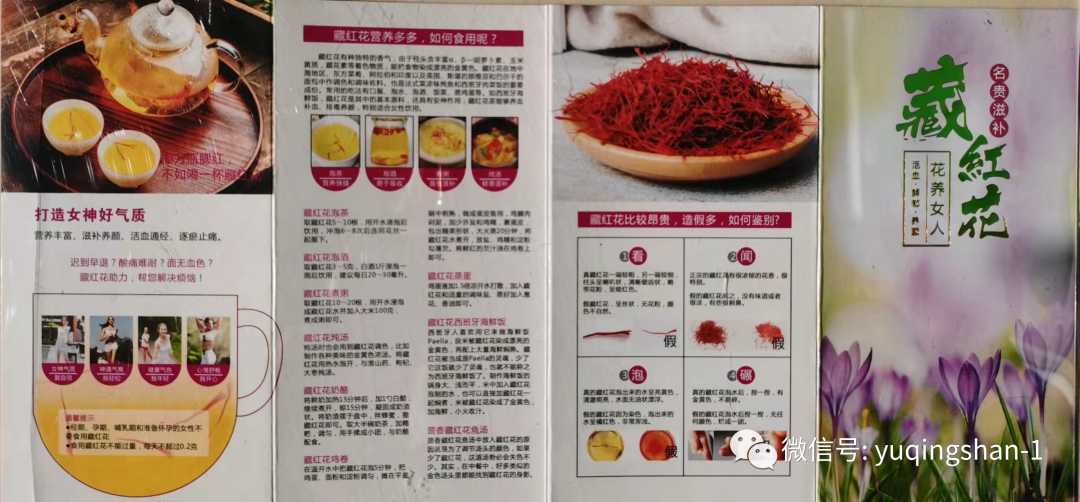
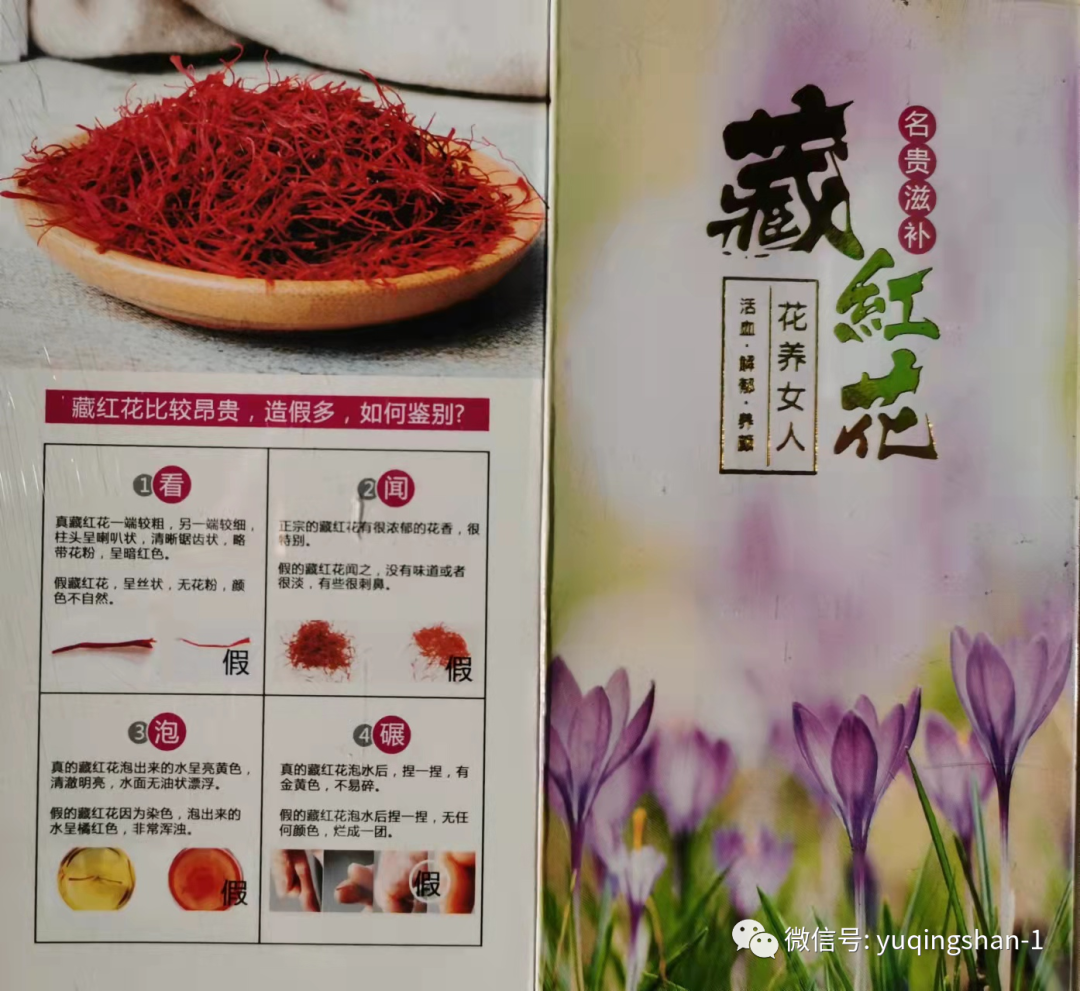
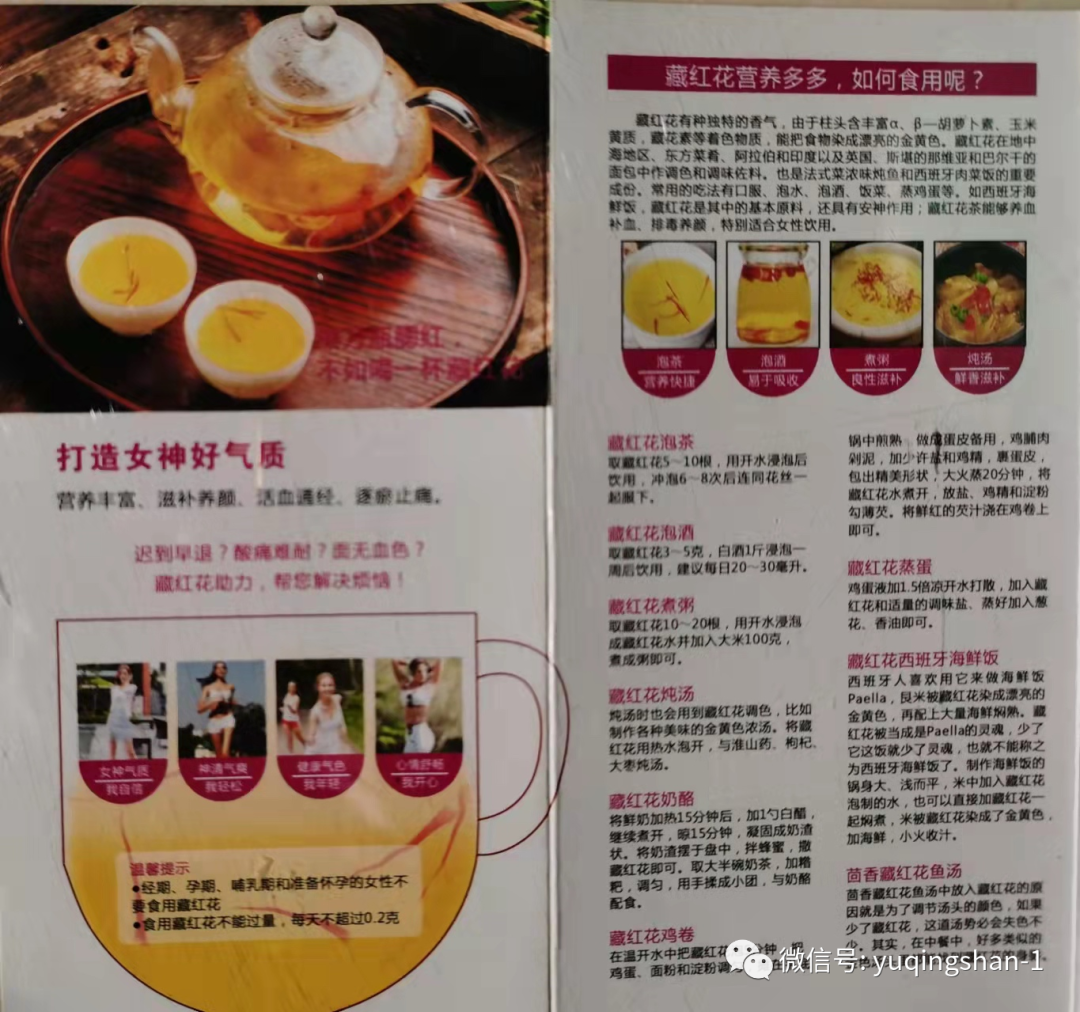
Zanghonghua, a name in Chinese medicine, refers to the dried stigmas of the plant Crocus sativus L. from the Iridaceae family. It has the effects of activating blood circulation, dispelling stasis, relieving depression, and detoxifying blood. It is mainly used for dysmenorrhea, amenorrhea, irregular menstruation, postpartum unclean lochia, abdominal masses, trauma, depression, palpitations, febrile diseases with rashes, and measles.
Alias: Xihonghua (西红花), Fan Honghua (番红花), Bofu Lan (泊夫蓝).
Properties: Sweet in flavor, neutral in nature; enters the Heart and Liver meridians.
Functions: Activates blood circulation, dispels stasis, relieves depression, and detoxifies blood.
Indications: Dysmenorrhea, amenorrhea, irregular menstruation, postpartum unclean lochia, abdominal masses, trauma, depression, palpitations, febrile diseases with rashes, and measles.
Usage and Dosage: Internal use: Decoction, 1-3g; can be infused or soaked in wine.
Precautions:
1. Contraindicated for pregnant women.
2. According to the Zhejiang Medicinal Plant Record: “Excessive menstrual bleeding and pregnant women should avoid use.”
Related Discussions:
1. Dietary Essentials: “Mainly for heart depression and accumulation, qi stagnation not dispersing. Long-term consumption brings joy to the heart.”
2. Essentials of Medicinal Compounds: “Mainly disperses depression, regulates blood, opens the chest, and promotes appetite. Long-term use nourishes the lower source, improves complexion, and treats febrile diseases with madness.”
3. Compendium of Materia Medica: “Activates blood. Also treats palpitations.”
4. Research on Materia Medica Usage: “More nourishing blood, less power to dispel stasis.”
5. Southern Medicine: “Treats blood stasis, irregular menstruation, postpartum unclean lochia, trauma, and pain due to stasis.”
6. Qingdao Handbook of Chinese Herbal Medicine: “Treats abdominal masses and pain.”
7. Zhejiang Medicinal Plant Record: “Activates blood circulation, dispels stasis, detoxifies blood. Main indications include masses, trauma pain, and blood-heat rashes.”
Clinical Applications:
1. Used for blood stasis syndromes. Saffron has the effect of activating blood circulation and dispelling stasis, commonly used for dysmenorrhea, amenorrhea, irregular menstruation, postpartum unclean lochia, abdominal pain, and trauma pain. It can be decocted alone or often combined with other blood-activating herbs to enhance efficacy. For dysmenorrhea and amenorrhea, it can be combined with Yimucao (益母草), Danshen (丹参), etc. For postpartum unclean lochia, it can be combined with Danggui (当归), Chishao (赤芍), etc.; this herb not only activates blood but also has the function of dispelling depression and opening stasis, which can be used for various stasis syndromes. For chest fullness and depression caused by worry and thought, it can be taken alone or combined with Yujin (郁金).
2. Used for febrile diseases with heat entering the blood, causing rashes and eruptions. Saffron can cool blood and detoxify, can be used alone or combined with other heat-clearing and detoxifying herbs, such as Daqingye (大青叶), Banlangen (板蓝根), etc. For measles with excessive heat and blood stasis, or rashes that do not surface well or are too dense, it is often combined with Zicao (紫草) and Chishao (赤芍).
Related Combinations:
1. For amenorrhea, dysmenorrhea, and postpartum back pain: 2g of saffron, 5g of Danshen, 30g of Yimucao, and 12g of Xiangfu. Decoct and take.
2. For postpartum stasis: 6g of Danpi, 6g of Danggui, 4.5g of Dahuang, 2g of saffron, and 6g of dried lotus leaf. Grind into powder. Take 6g three times a day with boiling water.
3. For irregular menstruation: 3g of saffron, 150g of black beans, and 90g of brown sugar. Decoct and take. (1-3 formulas from Qingdao Handbook of Chinese Herbal Medicine)
4. For pain in the waist, back, chest, and neck: (Saffron) ground and mixed with sheep heart, cow heart, or deer heart, roasted until red, applied to the heart. (《品汇精要》)
5. For trauma: 3g of saffron. Decoct with a little white wine. Wash the affected area. (《青岛中草药册》)
6. For vomiting blood, regardless of deficiency or excess, and any blood vomited: One flower of saffron, one cup of unburnt wine. Place the flower in the wine, stew to extract the juice and take. (《纲目拾遗》 quoting Wang Shiyao’s formula)
7. For various stasis: One flower of saffron, take with decoction. Avoid oily and salty foods, and prefer light porridge. (《纲目拾遗》)
8. For febrile diseases with madness and palpitations: Use 2 fen of saffron. Soak in one cup of water overnight. Take. (《纲目》 quoting Yilin Jiyao)
9. For otitis media: Fresh saffron juice and fresh mint juice in appropriate amounts, add a little white alum powder, mix well, and drip into the ear. (《青岛中草药手册》)
Identification of Medicinal Materials:
Identification:
1. The powder of this product is orange-red. The surface view of the epidermal cells is long and thin, with thin walls, slightly curved, some with the outer wall protruding into nipple-like or hair-like structures, and the surface has faint textures. The epidermal cells at the tip of the style are hair-like, with a diameter of 26-56μm, and the surface has sparse textures. Calcium oxalate crystals aggregate in parenchyma cells, appearing granular, round, spindle-shaped, or square, with a diameter of 2-14μm.
2. Take this product and soak it in water, and you will see orange-yellow lines descending straight down, gradually diffusing, dyeing the water yellow without sediment. The style appears trumpet-shaped with a short slit; when poked with a needle, it does not break easily.
3. Take a small amount of this product, place it on a white porcelain plate, add one drop of sulfuric acid, and the acid solution will show blue, then slowly change to reddish-brown or brown.
4. Take the absorbance of the solution under the light, and according to the ultraviolet-visible spectrophotometry method (general rule 0401), measure the absorbance at a wavelength of 458nm, and the ratio of absorbance at 458nm to that at 432nm should be 0.85-0.90.
5. Take 20mg of this product powder, add 1ml of methanol, treat with ultrasound for 10 minutes, let it stand to clarify, and take the supernatant as the test solution. Take 20mg of saffron reference material and prepare the reference material solution in the same way, perform thin-layer chromatography (TLC) test, applying 3-5μl of each solution on the same silica gel G thin-layer plate, using ethyl acetate-methanol-water (100:16.5:13.5) as the developing agent, develop, remove, and dry, and inspect under sunlight and ultraviolet light (365nm). In the test solution chromatogram, at the corresponding position of the reference material chromatogram, the same colored spots or fluorescent spots should appear (avoid light operation).
Medicinal Material Properties:
The complete style is linear, with a wider tip that gradually narrows to a tail-like shape, with irregularly toothed edges at the tip, and the lower end has a remnant yellow flower column. It is about 2.5m long and approximately 1.5mm in diameter. It is purple-red or dark reddish-brown with a slight sheen. It is light in weight, soft in texture, and becomes brittle and easy to break when dried. When the style is placed in water, it expands, showing orange-yellow lines descending straight down, gradually diffusing, dyeing the water yellow without sediment, and the style appears trumpet-shaped with a short slit. When poked with a needle, it does not break easily. It has a unique aroma, slightly irritating, and a slightly bitter taste.
For the best quality, it should be long, purple-red, moist, and shiny, with few yellow flower columns, and a slightly cool taste.
Herbal Slice Properties:
It consists of many styles gathered into a loose linear shape, with three branches, about 30mm long, dark red. The upper part is wider and slightly flat, with irregularly toothed edges, and the inner side has a short slit, while the lower end sometimes retains a small segment of the yellow flower column. It is light in weight, soft in texture, moist, and shiny, or without gloss and oily feel. It has a unique aroma, slightly irritating, and a slightly bitter taste.
Common Adulterants:
Confused Products:
Honghua: The dried tubular flowers of the plant Carthamus tinctorius L. from the Asteraceae family. The tubular flowers are about 1.5cm long, with a surface that is red-yellow or red, and the flower crown has 5 lobes at the tip; the style is long cylindrical, slightly bifurcated at the tip. It is soft in texture, has a faint fragrance, and a slightly bitter taste.
Adulterants:
1. Artificially fabricated products: Made from high-grade paper dyed deep red, then cut into narrow pieces that are wide at the top and narrow at the bottom, both sides red, with a light yellow-white center.
2. Chrysanthemum: Made from the ligulate and tubular flowers of Asteraceae plants dyed red. It appears dark red and oily.
Botanical Information:
Plant Species: Saffron from the Iridaceae family.
Morphological Characteristics: A perennial herb. The bulb is flat and round, about 3cm in diameter, covered with a yellow-brown membranous sheath. The leaves are basal, 9-15 pieces, linear, gray-green, 15-20cm long, and 2-3mm wide, with rolled edges; the basal leaf cluster is covered with 4-5 membranous sheath-like leaves. The flower stem is very short, not protruding from the ground; 1-2 flowers, pale blue, red-purple, or white, fragrant, with a diameter of 2.5-3cm; the flower segments are 6, arranged in 2 whorls, with the inner and outer segments being ovate, blunt at the tip, 4-5cm long; there are 3 upright stamens, 2.5cm long, with yellow anthers, pointed tips, and slightly curved; the style is orange-red, about 4cm long, with 3 branches at the top, which are curved and drooping, the stigma is slightly flat, wedge-shaped, with shallow teeth, longer than the stamens, and the ovary is narrow and spindle-shaped. The capsule is oval, about 3cm long and 1.5cm wide, with 3 blunt angles. The seeds are numerous and round. The flowering period is from October to November.
Distribution Area: Cultivated in small quantities in Zhejiang, Jiangxi, Jiangsu, Beijing, and Shanghai. Originally from southern Europe to Iran.
Growth Habits:
Prefers warm and humid coastal climates, is sensitive to heat, and is cold-resistant. Seedlings can withstand low temperatures of about -10℃; the optimal temperature for flowering is 14-20℃, and the soil temperature is suitable at 14-15℃; the optimal temperature for above-ground growth is 15℃. It prefers sunny, loose, fertile, humus-rich, and well-drained sandy loam. Avoid continuous cropping and waterlogging.
Propagation Methods: Propagated by bulbs.
Cultivation Techniques:
Bulb propagation: Before planting, select the land, plow, and rake to create high beds 1.3m wide, and level the bed surface. After the above-ground parts wither in April-May, dig out the bulbs, classify them into large, medium, and small sizes, with those over 25g as first grade, 8-25g as second grade, and under 8g as third grade. After summer storage, plant in September-October, with those over 8g planted at a spacing of 15cm×15cm, and those under 8g at a spacing of 10cm×10cm, covering with soil and straw. There are also methods of propagating bulbs after indoor flowering to increase the yield of styles and stigmas.
Pest and Disease Control:
1. Rot disease can be controlled by using the “indoor flowering outdoor propagation method” to stagger the disease period; before planting, soak seeds in 5% lime solution for 20 minutes; during the seedling stage, spray with 50% leaf blight agent at 1000 times or 75% white fungus control at 500 times.
2. Rot disease can be planted in well-drained land, and before planting, apply 1500kg of lime powder per hectare, mixing it into the soil for disinfection; during the disease period, irrigate with 50% tobuconazole at 1000 times.
3. Leaf disease can be controlled by planting bulbs from healthy plants.
4. Pests include grubs, mole crickets, and damage from mice and wild rabbits.
Differences in Efficacy between Zanghonghua and Honghua
Zanghonghua cools blood, detoxifies, and calms the mind. Honghua is good at stopping bleeding. Different sources: Zanghonghua, also known as Fan Honghua or Xihonghua, is the dried stigma of the plant from the Iridaceae family, with only three small stigmas per flower, making it very precious. Honghua, also known as Caohonghua or Honglanhua, is the dried tubular flower of the plant from the Asteraceae family.Different properties: Zanghonghua is dark red and mostly single, with a wider upper part and a narrower lower part, light in weight, soft, and has a special aroma.Different effects: Both Zanghonghua and Honghua can activate blood circulation and dispel stasis, but Zanghonghua also has the effects of cooling blood, detoxifying, and calming the mind, while Honghua is also good at stopping bleeding.
 Click the title below to view detailed content!
Click the title below to view detailed content!
Understanding Chinese Medicine | Banxia, Fabaniaxia, Jiangbanxia, Qingbanxia
Understanding Chinese Medicine | Fuling (with Fuzhen)
Understanding Chinese Medicine and Herbs – Licorice
Understanding Chinese Medicine and Herbs: Millet, a Chinese Medicine
Understanding Chinese Medicine and Herbs: Goji Berries
How to Eat Goji Berries, a Great Knowledge
Understanding Chinese Medicine and Herbs: The Efficacy and Function of Sha Yuanzizi, a Good Medicine for Nourishing the Liver and Kidney
Understanding Chinese Medicine and Herbs: The Efficacy and Function of Sesame Oil
Understanding Chinese Medicine and Herbs: The Efficacy and Function of Lead Red
Understanding a Chinese Medicine Material: Huangbai
Understanding a Chinese Medicine Material: Huangqin
Understanding a Chinese Medicine Material: Huanglian
Daily Understanding of a Chinese Medicine Material: Deer Antler
Daily Understanding of a Chinese Medicine Material: Weilingxian
Daily Understanding of a Chinese Medicine Material: Dangya!
Daily Understanding of a Chinese Medicine Material: Bingshu
Daily Understanding of a Chinese Medicine Material – Buguzi
Daily Understanding of a Chinese Medicine Material: Jujube
Chinese Medicine Popular Science || A single herb for treating high blood lipids, non-toxic and effective
A secret formula for treating hundreds of diseases with ants summarized
Daily Understanding of a Chinese Medicine Material: Wuweizi
Understanding a Chinese Medicine Material: Bamboo Leaf Ginseng, a folk herb that can solve 10 common diseases such as rheumatism and bone pain!
Hope this article helps you
 For more medical and health knowledge, follow this public account, and let us work together for future health.
For more medical and health knowledge, follow this public account, and let us work together for future health.
You have read  ·
·
 seconds, feeling good, you can forward or follow the QR code below
seconds, feeling good, you can forward or follow the QR code below


This subscription account disclaims responsibility
This subscription account disclaims responsibility
Copyright statement: This platform is dedicated to sharing good articles and selected readings. Some articles were pushed without contacting the original authors. Copyright belongs to the original authors, and if there is any infringement, please contact the original authors for deletion!
Copyright statement: This platform is dedicated to sharing good articles and selected readings. Some articles were pushed without contacting the original authors. Copyright belongs to the original authors, and if there is any infringement, please contact the original authors for deletion!
Special reminder: The authenticity and reliability of various dietary therapies and prescriptions mentioned in the article need to be considered by everyone, for reference only, please do not use blindly, and this platform does not bear any responsibility for any consequences arising therefrom.
Special reminder: The authenticity and reliability of various dietary therapies and prescriptions mentioned in the article need to be considered by everyone, for reference only, please do not use blindly, and this platform does not bear any responsibility for any consequences arising therefrom.
